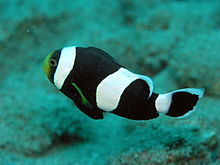Saddleback clownfish
| Saddleback clownfish | |
|---|---|
 |
|
| Scientific classification | |
| Kingdom: | Animalia |
| Phylum: | Chordata |
| Subphylum: | Vertebrata |
| Superclass: | Osteichthyes |
| Class: | Actinopterygii |
| Order: | Perciformes |
| Family: | Pomacentridae |
| Subfamily: | Amphiprioninae |
| Genus: | Amphiprion |
| Species: | A. polymnus |
| Binomial name | |
|
Amphiprion polymnus (Linnaeus, 1758) |
|
| Synonyms | |
|
Amphiprion bifasciatus |
|
Amphiprion bifasciatus
Amphiprion bifasciatus annamensis
Amphiprion intermedius
Amphiprion laticlavius
Amphiprion polynemus
Amphiprion trifasciatus
Anthias bifasciatus
Coracinus seu Sciaena unimaculata
Coracinus unimaculata
Lutjanus jourdin
Paramphiprion hainanensis
Perca polymna
Sciaena unimaculata
Amphiprion polymnus, also known as the saddleback clownfish or yellowfin anemonefish, is a black and white species of anemonefish with a distinctive saddle. Like all anemonefishes it forms a symbiotic mutualism with sea anemones and is unaffected by the stinging tentacles of the host anemone. It is a sequential hermaphrodite with a strict sized based dominance hierarchy: the female is largest, the breeding male is second largest, and the male non-breeders get progressively smaller as the hierarchy descends. They exhibit protandry, meaning the breeding male will change to female if the sole breeding female dies, with the largest non-breeder becomes the breeding male.
A. polymnus is a small sized fish which grows up to 13 centimetres (5.1 in). In any anemonefish group, the female is always larger than the male, but in this species the male is almost equal in size to the female. Its body has a stock appearance, oval shape, compressed laterally and with a round profile. The body color ranges from dark brown to yellow orange and this species has two or three white bars. The white head bar is thick and located just behind the eyes. A large white abbreviated saddle shape or slanted white bar across the middle of the fish's body makes it quite obvious to see how it got the name Saddleback. In some varieties, typically those specimens initially associated with Heteractis crispa anemone, the saddle shape may extend up onto the fish's Dorsal fin with a third white bar or margin located across the caudal peduncle, (pictured in taxobox). The external edge of the caudal and the anal fins are underlined with a white line. The snout and the pectoral fin are in any case of color variation orange yellow to brownish orange.
...
Wikipedia
